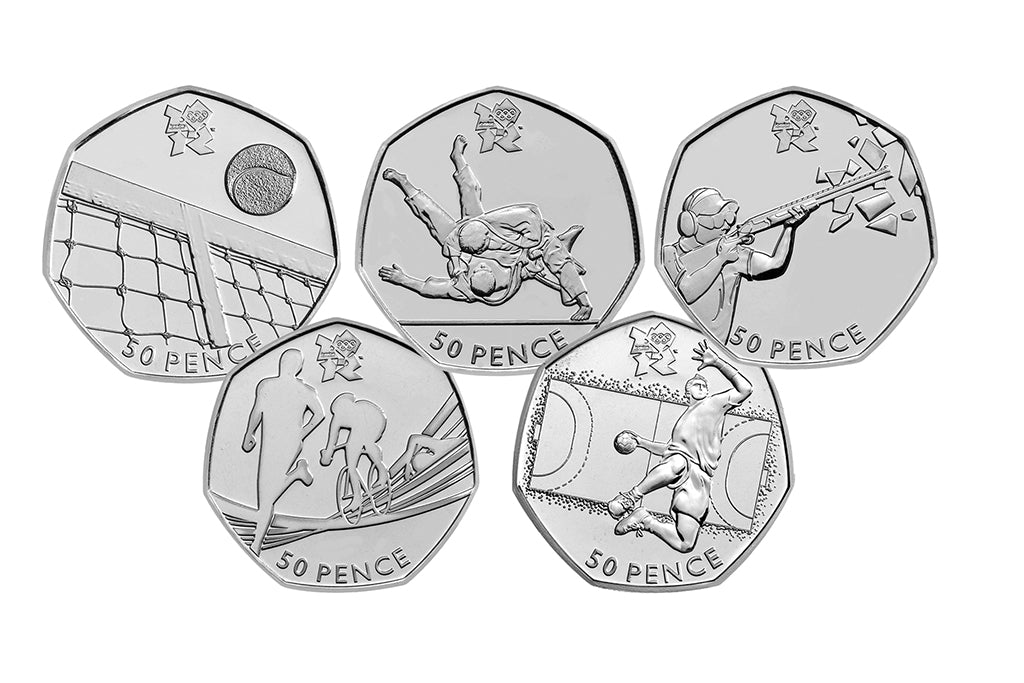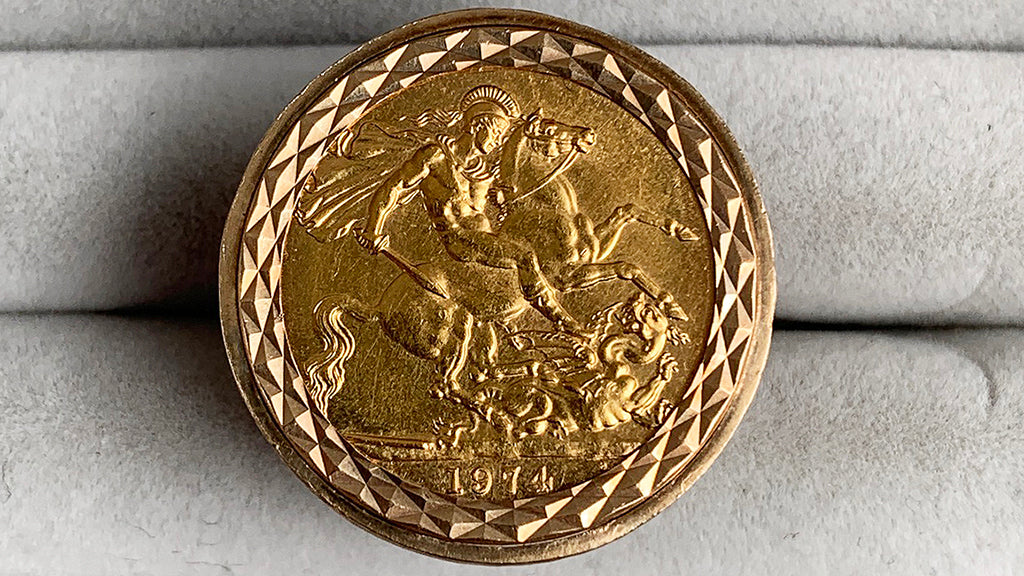Your Cart is Empty
Our bespoke remodelling service often acquaints us with old investment coins. Intrigued by the cultural tradition of collecting and inheriting coins like these, we’ve spent some time exploring the history of this practise and its place within society today. Whether you’re considering the pros and cons of investing in gold coins yourself, or simply as curious as we are about this time-honoured custom, you might enjoy this blog post – which covers a chronicle of investment coins through a British historical lens, their inextricable links to imperialism, opportunities to invest ethically in the 21st century, and the all-important question of whether it’s still worthwhile to do so.
 An inherited gold sovereign ring belonging to a client of ours
An inherited gold sovereign ring belonging to a client of ours
Investment coins, often referred to as bullion coins, are typically issued by governments and considered a reliable way to invest in precious metals like gold and silver. These coins are largely valued based on their metal content – though some are valued more highly for their rarity and significance - and are popular among investors who wish to hedge against inflation, economic instability, or currency devaluation.
 Collectable 50p coins from the Royal Mint’s coveted 2012 London Olympic Games set
Collectable 50p coins from the Royal Mint’s coveted 2012 London Olympic Games set
The practise of coin collecting boasts a rich history, with examples dating back to Ancient Greece and Rome. However, the act of formalised coin collecting really emerged in the Renaissance period when scholars and knowledgeable collectors began to appreciate coins for their historical, artistic, and cultural significance.
A little further down the line, the 17th century ushered in a significant British historical event known as the Great Recoinage of 1696, which involved the recall and reminting of old coins, leading to the production of new designs. These novel coins often featured intricate artwork and symbolism, their aesthetic appeal capturing the attention of enthusiasts. The Recoinage also aimed to standardise the British currency by ensuring that the weight and purity of each coin matched its face value, making it much easier for a collector to assess its authenticity and value.
Naturally, the old coins recalled during the Recoinage – particularly those boasting rare and unique features – also became sought-after collectibles. Either with a view of fortifying their collections or making a long-term financial investment, experts saw the opportunity to acquire coins that were being phased out. As people began using the newly minted coins in their day-to-day lives, more grew curious about those being withdrawn from circulation, spurring greater interest in the history and significance of coins.
By the 18th century, numismatic societies like the Society of Antiquaries of London had been established, growing in popularity as the British Empire expanded and the British Royal Mint produced colonial coins for a vast range of territories, including East India Company Coins, British West Africa Coins, the Hong Kong Dollar, and the Straits Settlements Dollar.
The British Royal Mint began issuing commemorative coins in the 20th century to mark significant events like royal weddings, historical anniversaries, and sporting events. To date, some of the most sought-after and valuable Royal Mint coins include the 1952 King George Proof Set from the year of King George VI’s death, the 1983 22ct £2 gold coin issued to commemorate the 300th anniversary of the gold standard in Britain, and the 29 50p coins produced to celebrate the 2012 London Olympics.
 Kruger and Krugerrand
Kruger and Krugerrand
Though investment coins are now produced and collected for a variety of reasons beyond their historical context, it’s important for anyone ready to dip a toe into investment coin waters to understand that many older coins are inextricably linked to European imperialism.
Arguably, the primary goal of powerful European nations between the 18th and 20th centuries was to exploit the resources of conquered territories, including precious metals. For example, whilst Spain plundered 181 tonnes of gold from Mexico, Central America and South America over the course of 150 years, Portugal, The Dutch Republic, Great Britain, Denmark, Sweden and France are all nations that benefitted from the gold resource on Africa’s so-called ‘Gold Coast’.
Historic investment coins were largely produced from the precious metals extracted from these colonies and went on to play a role in financing imperial endeavours. Often used for trade within the empire and with other powerful nations, investment coins were a tool for maintaining dominance and the stability of the imperial economy, collecting revenue and transferring wealth back to the imperial centre of Europe.
Investment coins produced during the Age of Imperialism largely feature iconography of monarchs, imperial symbols or political messages; tangible celebrations of colonialist regimes. Today, these coins are desirable and highly valued collectible items, often sought out for their ‘exotic’ intrigue and connections to the Empire.
For example, the South African Krugerrand is one of the most iconic and historically significant gold bullion coins in the world. First introduced in 1967 by the South African government as a way to promote the country's vast gold reserves, it was named after Paul Kruger, a dominant political and military figure in South Africa of German, French and Dutch ancestry. Though Kruger himself lived before the apartheid system was enacted by the National Party in 1948, he was responsible for implementing policies limiting political and labour rights for non-white populations, applying immigration policies that aimed to attract and maintain a predominantly white population, and enforcing separation between racial groups in various aspects of life, including education and public facilities. The world’s first coin to contain exactly one ounce of fine gold, the Krugerrand was unique at the time of introduction and quickly gained significant international popularity as an investment vehicle during the 1970s and 1980s, despite South Africa operating under an apartheid system at the time. Today, the South African Krugerrand remains a popular choice for gold investors worldwide – still bearing an image of Paul Kruger.
If you’re thinking of investing in gold coins, it’s worth carrying out some research on the origins and symbolism of certain collectibles and thinking about how they sit with you. Do you wish to invest in a piece of history that symbolises white supremacy?
 Betts’ ‘Conserve’ bullion coin from Mali’s Yanfolila mine
Betts’ ‘Conserve’ bullion coin from Mali’s Yanfolila mine
Betts Metals is the only UK-based gold refinery accredited to produce Fairtrade Gold, and the world’s first Single Mine Origin (SMO) refiner. Betts’ SMO gold is 24ct pure gold, produced and refined from one single mine site and plant; the Yanfolila operation in Mali, West Africa. A legitimate mining operation, Yanfolila bears no ties to conflict and upholds fair trading relationships. For the ethics-conscious investor who wishes to put their money where their coin is, Betts’ Hummingbird investment coins are available in a variety of sizes and designs, crafted in 99.99% pure SMO gold. They’re an opportunity to support miners who are being paid just wages under secure and safe employment, residing in a region where legal business is thriving and sustainability initiatives are in place.
What’s more, the purchase of certain coins – such as the 2018 ‘Conserve’ coin – facilitates fixed percentage donations to conservation charities local to the Yanfolila mine.
Meanwhile, the UK’s Royal Mint announced pioneering plans to set new sustainability standards this year, including recovering gold from electrical circuit boards using world-first technology and refining surplus gold from the production of new bullion coins into 400oz investment bars. For investors and collectors keen to minimise their carbon footprint and champion circularity, these plans are worth keeping an eye on.
 ‘Money Don’t Grow on Trees’ by Philip Leister
‘Money Don’t Grow on Trees’ by Philip Leister
Many bullion coins are valued primarily for their precious metal content. Investing in weighty silver and gold coins is a means of hedging against inflation and economic uncertainty, as the value of precious metals tends to rise gradually over time. Here at Lebrusan Studio, we recently created a gold wedding band for a client by way of recycling his large inherited 22ct gold sovereign ring, whose value lay almost entirely in its gold content. Allowing us to sell the ring off, our client was able to credit its scrap metal value against the final price of his order, paying less for his new wedding band than he would have done otherwise. If you’re a jewellery enthusiast, collecting coins with high precious metal contents may create exciting opportunities for recycling and remodelling in the future. Investment coins valued for their metal content are relatively easy to buy and sell, but are best considered long-term investments, since the increase of precious metal prices is a slow and steady process over many years.
Meanwhile, many limited edition coins - especially those produced for commemorative purposes or as parts of sets – possess additional collectors’ value beyond their metal content. The rarity, historical significance, design, and condition of these coins is what impacts their market value. Unlike mass-produced bullion coins, collector's coins are generally prone to value fluctuations over much shorter periods. If you’re thinking about investing in coins, it’s important to consider your investment timeline, the extent to which you’re willing to observe the market, and how easily you might like to sell them on.
Before investing in any coin, it's important to conduct thorough research and seek expert authentication if necessary.
